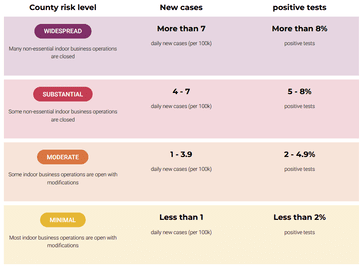That’s the word from Marin County Public Health Officer Dr. Matt Willis, who said this week that Marin could advance from the red tier 2 to the orange tier 3 within the statewide Blueprint for a Safer Economy framework as soon as Oct. 27, a move that would allow several business sectors to move from 25% to 50% density indoors.
“We may be heading to tier three in a matter of weeks,” Willis told the Marin County Board of Supervisors Tuesday, noting that Marin recorded a total of 68 coronavirus cases in the past week, the lowest number of cases in a given seven-day period since May. “This is up to us. We do have control over our behavior and we know what it takes: cover our faces, maintain physical distance, wash our hands and avoid large gatherings. This isn’t a sign that we can relax our strategies. It’s not complex in many ways, though it is challenging, especially as the months wear on. Let’s make sure that we don’t make the mistakes that seem to be occurring in other parts of the country now.”
The rosy assessment is the first indication of sustained COVID-19 metrics progress in months. It comes on the heels of the allowance for hair salons and barbershops to open five weeks ago for the first time since late June, and for restaurants to reopen indoor dining for the first time since it was allowed to do so on June 29, only to have indoor dining’s return reversed just a few days later when Marin was placed on the watch list as a result of a sustained spike in COVID-19 metrics.
The first steps toward sustained progress kicked off Sept. 15 for an array of business sectors, as retailers and hair salons could expand to 50% capacity, nail salons could open indoors, places of worship and movie theaters could open at 25% capacity and restaurants opened indoors at 25% capacity. If Willis’ prediction rings true, those sectors could move to 50% density indoors in late October, a significant step forward to creating a business model that might actually pencil out, according to many Mill Valley business owners. It would also allow offices to open for the first time.
As of Oct. 5, Marin’s adjusted daily case rate is 4.3 with a 1.8% test positivity rate. As expected, the state has added a third indicator – an “equity metric” – to compare a county’s COVID-19 percent positivity rate across low-income neighborhoods like the Canal and Marin City to more affluent neighborhoods and ensure that Marin’s lowest income, most marginalized communities aren’t left behind as counties move up in the tier system.
The equity metric requires counties to demonstrate a positivity percentage of 5.2% or less among the quartile of their census tracts that score the lowest on the “healthy places index.” In Marin, those census tracts include the Canal neighborhood in San Rafael, as well as Marin City and parts of West Marin and Novato. The census tracts are based on the economic, education, transportation, social, neighborhood, housing, clean environment and health care access.
Willis said that while the Canal’s positivity percentage in the Canal neighborhood was 18% in mid-September, Marin’s lowest quartile currently has a positivity rate of just 3%.
“We’re seeing significant progress,” Dr. Matt Willis told the Board of Supervisors. “Our case counts, hospitalizations and percent positivity rate are the lowest they’ve been in about four months.”

